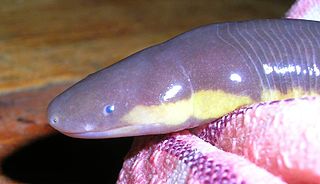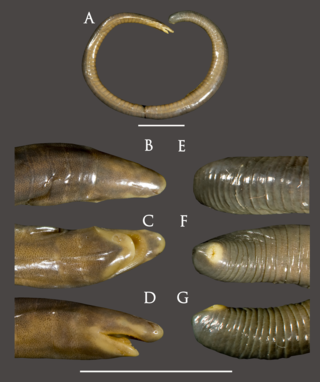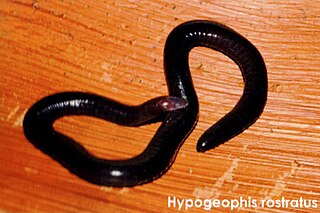
Caecilians are a group of limbless, vermiform (worm-shaped) or serpentine (snake-shaped) amphibians. They mostly live hidden in soil or in streambeds, and this cryptic lifestyle renders caecilians among the least familiar amphibians. Modern caecilians live in the tropics of South and Central America, Africa, and southern Asia. Caecilians feed on small subterranean creatures such as earthworms. The body is cylindrical and often darkly coloured, and the skull is bullet-shaped and strongly built. Caecilian heads have several unique adaptations, including fused cranial and jaw bones, a two-part system of jaw muscles, and a chemosensory tentacle in front of the eye. The skin is slimy and bears ringlike markings or grooves, which may contain tiny scales.

Rhinatrematidae is a family of caecilians, also known as the Neotropical tailed caecilians, American tailed caecilians. or beaked caecilians. They are found in the equatorial countries of South America.

The Ichthyophiidae are the family of Asiatic tailed caecilians or fish caecilians found in South and Southeast Asia as well as southernmost China.

Sooglossidae, the Seychelles frogs or Seychelles Island frogs, are a family of frogs found on the Seychelles Islands. Until recently, this family was believed to include the genera Sechellophryne, Nesomantis and Sooglossus, but following a major revision of amphibians in 2006, the genus Nesomantis was named a junior synonym of Sooglossus. Their closest relatives are the purple frogs (Nasikabatrachidae) of India.

Ichthyophis garoensis, the Garo Hills caecilian, is a species of caecilian found in Assam and Meghalaya in north-eastern India. The Husain's caecilian Ichthyophis husaini was until 2016 considered a separate species. It is a subterranean caecilian that lives in the moist leaf-litter of tropical forests. It is typically found close to streams and other waterbodies.
Chikila fulleri, also known as the Kuttal caecilian, Fuller's caecilian, and Fuller's chikila, is a species of caecilian from South Asia. In 2012 it was reassigned to a newly erected family, Chikilidae.

Microcaecilia is a genus of caecilians in the family Siphonopidae.
Mimosiphonops is a genus of caecilians in the family Siphonopidae. The genus is definitely known only from the state of Rio de Janeiro, Brazil. They are sometimes known as the worm patterned caecilians.
Crotaphatrema lamottei, the Mount Oku caecilian or Lamotte's caecilian, is a species of caecilian in the family Scolecomorphidae. It is endemic to Mount Oku in Cameroon. The specific name lamottei honours Maxime Lamotte, French biologist. There is some doubt whether Crotaphatrema tchabalmbaboensis really is distinct from this species.
Indotyphlus is a small genus of caecilians in the family Grandisoniidae. As caecilians in general, they superficially resemble earthworms. The genus is endemic to the Western Ghats, India. They are sometimes known as Battersby's caecilians.
Microcaecilia iwokramae is a species of caecilian in the family Siphonopidae. It is endemic to Guyana and only known from its type locality in the Iwokrama Forest. It was first described as Caecilita iwokramae in the monotypic genus Caecilita, before being recognised as belonging to Microcaecilia.

Sathyabhama Das Biju is an Indian amphibian biologist, wildlife conservationist and heads the Systematics Lab at the University of Delhi, Department of Environmental Studies. He is dubbed as the "Frogman of India" by media for his passion for frogs and for bringing fresh fascination for Indian amphibians. In an interview with Sanctuary Asia, he was introduced as "one of the world's foremost amphibian experts".

Chikilidae is a family of Indian caecilians, the 10th and most recent (2012) family of caecilians to be identified, although the type species, Chikila fulleri was first described in 1904. The discovery that this was a separate lineage resulted from genetic analyses of specimens collected during about 250 soil-digging expeditions over five years that covered every Northeast Indian state. A team of biologists led by University of Delhi herpetologist Sathyabhama Das Biju described the family as representing as many as seven species apparently endemic to the region. In September 2012, some of these species were also found in Lawachara National Park in the Sylhet region of northeastern Bangladesh. The family's lineage is believed to have originated in Africa, where their closest living relatives are found.

Herpelidae are a family of caecilians, sometimes known as the African caecilians. They are found in Sub-Saharan Africa. Like other caecilians, they superficially resemble worms or snakes. They are the sister group to the newly discovered Chikilidae.

The Grandisoniidae are a family of common caecilians found in Africa, Seychelles and India. Like other caecilians, they superficially resemble worms or snakes. The family was formerly known as Indotyphlidae.
Ichthyophis moustakius, the Manipur moustached caecilian, is a species of caecilian in the family Ichthyophiidae. It is endemic to Northeast India. This species exhibits broad lateral yellow stripes from the anterior part of its tail, along its mandibles, between its nares, as well as elsewhere. The animal can reach a length of 300 millimetres (12 in). Its head is somewhat U-shaped and fairly short; scales are absent on its collars. The species' name is derived from the Greek word moustakius, meaning "moustache", due to the yellow arched stripes it possesses.
Ichthyophis multicolor is a species of caecilians endemic to Burma. It is only known from its type locality in the Ayeyarwady Region. A unique characteristic of this species is that it is the only Ichthyophis species besides I. tricolor that has a pale vent, as well as an adjacent darker stripe running lengthwise down the vent's sides.
Ichthyophis khumhzi, the Khumhzi striped ichthyophis, is a species of caecilian found in India. It has narrow and irregular lateral yellow stripes. It can attain lengths larger than 400 mm (16 in). Its head is V-shaped while short; the animal shows scales as far anterior as its collars. The species is named after Khumhzi village, where the specimens were first collected.
Ichthyophis sendenyu, the Sendenyu striped ichthyophis, is a species of caecilian found in India. This species of Ichthyophis possesses broad and solid lateral yellow stripes from about the level of the posterior of its disc to its eye level on the upper jaw, while arched yellow stripes extend to its nares. Its length does not exceed 350 millimetres (14 in). Its head is U-shaped and short. Scales are present in anteriormost grooves, with five to eight rows placed posteriorly on its dorsum. It is named after Sendenyu village, Nagaland, where the species was first found.










